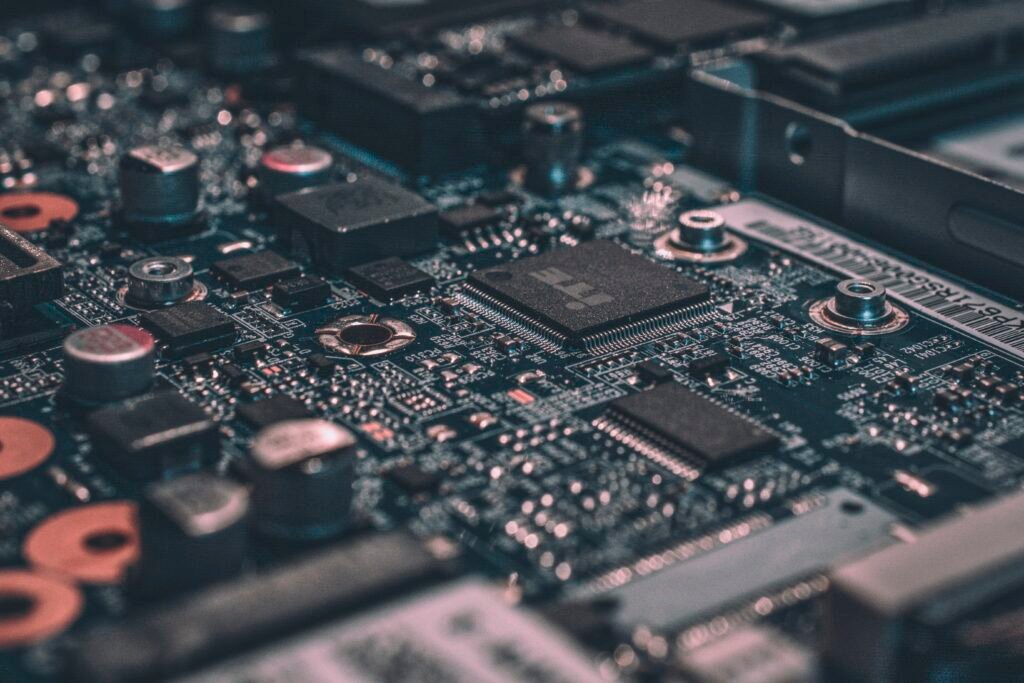Imagine a world where containers are not just steel boxes, but innovative marvels of technology. Picture containers that can detect and monitor their own conditions, optimizing storage and minimizing damage. This is not a far-fetched concept, but rather the exciting reality of the advancements in container manufacturing. In this article, we will explore the incredible breakthroughs that are revolutionizing the container industry, unlocking endless possibilities for logistics and global trade. Prepare to be amazed at the potential of these technological wonders.
1. 3D Printing

This image is property of images.unsplash.com.
Using additive manufacturing in container production
One of the most significant technological breakthroughs in container manufacturing is the application of 3D printing, also known as additive manufacturing. This innovative process allows for the creation of containers layer by layer, using various materials such as plastics, metals, and ceramics. By utilizing 3D printing, manufacturers can revolutionize container production, resulting in numerous benefits and opportunities.
Benefits of 3D printing in container manufacturing
The implementation of 3D printing in container manufacturing brings forth a multitude of benefits. Firstly, it offers unparalleled design freedom, allowing containers to be uniquely tailored to specific requirements. Whether it’s intricate shapes, custom sizes, or complex geometries, 3D printing enables the production of containers that were previously unattainable through traditional manufacturing methods. This level of customization enhances functionality and optimizes space utilization.
Additionally, 3D printing significantly reduces production time. Traditional container manufacturing involves multiple processes, including molding, assembly, and finishing. With additive manufacturing, containers can be produced in a single step, eliminating the need for time-consuming procedures. This streamlined approach not only accelerates production but also ensures efficient resource allocation, resulting in cost savings for manufacturers.
Case studies of successful implementation
Several notable case studies highlight the successful implementation of 3D printing in container manufacturing. For instance, in the aerospace industry, Boeing has utilized 3D printing to produce lightweight, yet durable, containers for storage and transportation purposes. This application has not only improved operational efficiency but also reduced fuel consumption and emissions during air transportation.
In the pharmaceutical sector, Aprecia Pharmaceuticals has employed 3D printing to manufacture personalized medicine containers. The ability to create customized dosages in containers that are tailored to individual patient needs has revolutionized drug delivery. 3D printing has facilitated the production of complex and unique container designs, ensuring accurate medication dosing and improving patient adherence.
These case studies indicate the immense potential of 3D printing in container manufacturing across various industries. As the technology continues to evolve, we can expect to see further advancements and applications in this field.
2. Smart Containers
Integration of Internet of Things (IoT) technology
The integration of Internet of Things (IoT) technology has ushered in a new era of smart containers. These containers are equipped with sensors and connected to a network, enabling real-time tracking and monitoring throughout the supply chain.
Real-time tracking and monitoring of containers
Smart containers leverage IoT technology to provide accurate and real-time tracking of containers throughout their journey. Sensors integrated into the containers transmit location data, allowing stakeholders to precisely monitor and track the movement and location of containers. This level of visibility enables greater control over inventory management, reduces the risk of loss or theft, and enhances overall supply chain efficiency.
Furthermore, smart containers can also monitor various environmental factors such as temperature, humidity, and pressure. This capability is particularly crucial in industries such as pharmaceuticals and food, where maintaining optimal conditions during transportation is paramount. Instant notifications and alerts can be generated if any deviations from pre-defined thresholds occur, ensuring timely action to prevent product spoilage.
Enhancing supply chain efficiency
The implementation of smart containers brings forth a myriad of benefits that enhance supply chain efficiency. With real-time data on container locations, shipping operators can optimize routes, minimize transit time, and reduce unnecessary delays. This increased efficiency not only improves customer satisfaction by ensuring timely and reliable deliveries but also reduces operational costs by minimizing fuel consumption and idle time.
Another significant advantage is the ability to proactively identify and resolve potential issues. If a container is delayed, damaged, or exposed to unfavorable environmental conditions, immediate action can be taken to mitigate the impact and ensure the integrity of the transported goods. This proactive approach minimizes the risk of product spoilage, damage, or losses.
Improved safety and security measures
Smart containers also enhance safety and security measures in container transportation. With continuous monitoring and real-time alerts, any unauthorized access or tampering can be quickly identified and addressed. Additionally, smart containers can be integrated with advanced lock systems and biometric technology, further enhancing security measures. These advancements significantly reduce the risk of theft and unauthorized access, ensuring the safety of valuable goods throughout the supply chain.
In conclusion, the integration of IoT technology in container manufacturing has paved the way for smart containers, bringing increased visibility, efficiency, and security to the global supply chain.
3. Lightweight Materials
Exploring composites and advanced alloys
Container manufacturers are exploring the use of lightweight materials such as composites and advanced alloys to reduce container weight without compromising strength.
Reducing container weight without compromising strength
Lightweight materials offer a compelling solution to the challenge of reducing container weight without compromising structural integrity. Composites, composed of two or more materials with different properties, provide a high strength-to-weight ratio. By combining materials such as fiberglass, carbon fiber, and resins, manufacturers can create containers that are significantly lighter than traditional options while maintaining excellent durability.
Similarly, advanced alloys, which are specially engineered combinations of metals, offer superior strength and lightweight characteristics. Containers made from these alloys possess excellent resistance to corrosion, contributing to their longevity and overall durability.

This image is property of images.unsplash.com.
Lowering shipping costs and carbon emissions
The use of lightweight materials in container manufacturing has a twofold impact: it lowers shipping costs and reduces carbon emissions. Lighter containers require less fuel to transport, resulting in reduced shipping costs for manufacturers and logistics providers. Additionally, lower fuel consumption translates to decreased carbon emissions, making container transportation more environmentally friendly.
Moreover, lightweight containers allow for increased payload capacity. Shipping operators can transport more goods within weight limits set by regulations, maximizing the utilization of each shipment and minimizing the number of trips required. This optimization in cargo capacity results in further cost savings and reduced carbon footprint, making lightweight containers an attractive choice for sustainability-conscious organizations.
In summary, the exploration and utilization of lightweight materials in container manufacturing offer a significant opportunity to reduce weight, lower shipping costs, and minimize the environmental impact of container transportation.
4. Self-Repairing Containers
Introduction of self-healing materials
The concept of self-repairing containers has emerged as a promising technological breakthrough in container manufacturing. Self-healing materials, capable of detecting and repairing minor damages, have the potential to extend container lifespan and reduce maintenance requirements.
Detecting and repairing minor damages
Self-repairing containers incorporate materials that possess unique properties enabling them to detect and repair minor damages automatically. When a container sustains superficial scratches, cracks, or other forms of damage, the self-healing material around the area activates, filling in the gaps and restoring structural integrity. This autonomous repair process ensures that minor damages do not escalate into significant issues that compromise container functionality.
Extending container lifespan and reducing maintenance
The ability of self-repairing containers to autonomously repair minor damages has significant implications for container lifespan and maintenance requirements. By proactively addressing minor damages, the need for manual repairs and maintenance is greatly reduced, leading to cost savings for container owners and operators.
Furthermore, the extension of container lifespan contributes to sustainability efforts. With self-repairing materials, containers can remain in service for a more extended period, reducing the demand for new container production. This reduction in resource consumption and waste generation aligns with the principles of a circular economy and promotes long-term environmental stewardship.
Although the technology for self-repairing containers is still in its early stages, the potential benefits it offers are promising. As further research and development are conducted, self-healing materials may become a standard feature in container manufacturing, revolutionizing the industry’s maintenance practices and overall lifecycle management.
5. Nanotechnology
Utilizing nanomaterials in container manufacturing
Nanotechnology has opened up new opportunities in container manufacturing by utilizing nanomaterials to enhance various properties and performance aspects of containers.
Enhancing barrier properties and insulation
By incorporating nanomaterials, containers can achieve remarkable improvements in barrier properties and insulation. Nanomaterials have unique characteristics due to their small particle size, which allows them to form highly effective barriers against gases, liquids, and other substances. This enhanced barrier functionality ensures the integrity of the container’s contents, protecting them from external factors such as moisture, oxygen, and contaminants.
Additionally, nanomaterials offer exceptional insulation properties. They can effectively minimize heat transfer, preventing temperature fluctuations inside the container during transportation. This insulation capability is particularly valuable for perishable goods that require strict temperature control, such as pharmaceuticals, food, and sensitive electronic components.
Preventing corrosion and contamination
Another advantage of nanotechnology in container manufacturing is its ability to prevent corrosion and contamination. Nanomaterial coatings can be applied on container surfaces, creating a protective layer that repels water, chemicals, and other corrosive substances. This preventive measure significantly extends the lifespan of containers and reduces the need for frequent maintenance and repairs.
Furthermore, nanotechnology can contribute to mitigating contamination risks by inhibiting the growth of microorganisms and reducing the adhesion of particles and contaminants to container surfaces. This antibacterial and anti-contamination property ensures the safety and integrity of the transported goods, particularly in industries where hygienic conditions are critical.
Overall, the integration of nanotechnology and nanomaterials in container manufacturing presents opportunities to enhance barrier properties, insulation, and anti-corrosion performance, contributing to the preservation of product quality and safety.
6. Automation and Robotics
Implementation of automation in container production
Automation and robotics have gained significant traction in container production, revolutionizing manufacturing processes and improving operational efficiency.
Robotic assembly lines for increased efficiency
The implementation of robotic assembly lines in container production has generated substantial improvements in efficiency. Robots can perform repetitive and labor-intensive tasks with precision and speed, ensuring consistent quality in container manufacturing. Automated processes, such as welding, assembling, and painting, increase throughput rates, minimize errors, and reduce the reliance on human labor.
Furthermore, the use of robotics enables manufacturers to optimize space utilization in production facilities. Robots can be programmed to work in tight spaces and perform intricate motions, allowing for more compact manufacturing layouts. This optimization not only enhances efficiency but also facilitates the scaling of production capacity as demand increases.

This image is property of images.unsplash.com.
Reducing human error and labor costs
Automation in container production significantly reduces the risk of human error, enhancing the overall quality and reliability of containers. Machines can consistently perform tasks with precise measurements and minimal deviations, minimizing the likelihood of defects and inconsistencies.
Moreover, the integration of automation and robotics in container manufacturing helps reduce labor costs. While robots handle repetitive tasks, human workers can be assigned to more complex and value-added activities, such as quality control, system monitoring, and process optimization. This optimized allocation of human resources improves overall productivity and allows manufacturers to focus on higher-value activities that require creativity and problem-solving skills.
In conclusion, the implementation of automation and robotics in container manufacturing presents opportunities to streamline processes, improve efficiency, and reduce human error, ultimately enhancing the competitiveness of container manufacturers.
7. Sustainable Containers
Incorporating eco-friendly materials and design
The growing emphasis on sustainability has spurred the incorporation of eco-friendly materials and design principles in container manufacturing. The use of sustainable containers not only reduces the environmental impact but also aligns with circular economy principles.
Reducing environmental impact of container manufacturing
The incorporation of eco-friendly materials in container manufacturing helps reduce the environmental impact of production. Sustainable materials, such as recycled plastics, bio-based composites, and responsibly sourced metals, reduce the reliance on virgin resources, minimizing energy consumption and carbon emissions.
Furthermore, sustainable container design aims to optimize material usage and minimize waste generation. Intelligent design practices, such as nesting and modular designs, maximize space utilization during transportation and storage, reducing the need for additional containers and minimizing fuel consumption.
Promoting circular economy principles
Sustainable containers promote the principles of a circular economy by prioritizing durability and extended lifespan. By designing containers to withstand multiple trips and implementing repair and maintenance programs, container manufacturers contribute to reducing waste generation and resource consumption. This approach ensures that containers remain in service for longer periods, minimizing the need for frequent replacements and reducing overall environmental impact.
Moreover, sustainable containers can be recycled at the end of their lifespan, feeding back into the manufacturing process and closing the materials loop. Recycling and repurposing containers contribute to the circularity of resources and reduce the burden on landfills.
In summary, the incorporation of eco-friendly materials and design principles in container manufacturing supports environmental sustainability, reduces resource consumption, and promotes the principles of a circular economy.
8. Improved Insulation
Advancements in thermal and sound insulation
Technological advancements have led to significant improvements in insulation capabilities of containers, ensuring optimal conditions during transportation and preventing temperature fluctuations and product spoilage.
Maintaining optimal conditions during transportation
Containers serving industries such as pharmaceuticals, food, and electronics require precise temperature control to maintain the quality and integrity of the transported goods. Advancements in thermal insulation technology enable containers to maintain stable internal temperatures, regardless of external climatic conditions.
High-performance insulation materials, such as foams and aerogels, effectively minimize heat transfer and thermal conductivity, providing excellent insulation properties. These advancements ensure that containers maintain the desired temperature range, protecting sensitive products from degradation or spoilage.
Preventing temperature fluctuations and product spoilage
Temperature fluctuations during transportation can have detrimental effects on product quality and safety. Improved insulation in containers minimizes temperature fluctuations, ensuring that goods are maintained within the recommended range throughout the journey.
Preventing temperature fluctuations is particularly crucial for perishable goods, such as fresh produce and pharmaceuticals, where even slight deviations can lead to spoilage, degradation, or loss of efficacy. By maintaining stable temperatures, containers contribute to the preservation of product quality, minimization of waste, and ultimately, enhanced customer satisfaction.
In conclusion, advancements in insulation technology have significantly improved container performance by maintaining stable internal temperatures, preventing temperature fluctuations, and safeguarding the quality and integrity of transported goods.
9. Advanced Security Features
Integrating biometrics and advanced lock systems
To enhance security in container transportation, advanced security features such as biometrics and improved lock systems are being integrated into container design and manufacturing.
Preventing theft and unauthorized access
Containers are susceptible to theft and unauthorized access, making security a top priority for container manufacturers and logistics companies. By integrating biometric technology, containers can employ fingerprint or retinal scans, ensuring that only authorized personnel can access their contents. This enhanced security measure reduces the risk of theft, illegal tampering, and unauthorized access, safeguarding the integrity of the transported goods.
Ensuring the integrity of transported goods
Advanced lock systems offer improved security measures, preventing unauthorized access and ensuring the integrity of transported goods. These locks are often equipped with tamper-proof features, making it significantly more challenging for thieves to infiltrate containers. Additionally, these lock systems can be integrated with real-time tracking and monitoring technologies, providing stakeholders with immediate alerts in case of any abnormal activity or breach of security.
With the integration of advanced security features, container manufacturers and logistics providers can establish a reliable and secure framework for container transportation. Enhanced security measures reduce the risk of theft, tampering, and unauthorized access, ensuring the integrity and safety of the transported goods.
10. Customization and Personalization
Tailoring containers to specific customer needs
In response to evolving customer demands, container manufacturers are increasingly offering customization and personalization options. By tailoring containers to suit specific requirements, manufacturers can enhance branding and customer satisfaction.
Offering various sizes, shapes, and features
The ability to customize containers to specific customer needs allows manufacturers to provide tailored solutions that maximize operational efficiency. Containers can be designed in various sizes, shapes, and configurations to accommodate diverse cargo types, such as oversized or delicate goods. This customization enables efficient utilization of container space, reduces the risk of damage, and optimizes shipping costs.
Additionally, containers can be equipped with specialized features, such as adjustable internal compartments, secure fastening mechanisms, and integrated tracking systems. These additional features enhance the functionality and convenience of containers, providing added value to customers.
Enhancing branding and customer satisfaction
Customization and personalization options in container manufacturing offer opportunities for companies to enhance their brand image and increase customer satisfaction. Containers can be branded with company logos, colors, and unique designs, making them instantly recognizable and reinforcing brand identity. This branding opportunity extends beyond traditional shipping to areas such as pop-up stores, events, and exhibitions, where containers serve as innovative and eye-catching marketing tools.
Tailored containers also contribute to customer satisfaction by aligning with specific operational requirements and improving the overall experience. Companies can collaborate with container manufacturers to co-create containers that meet their unique needs, resulting in increased efficiency, reduced risks, and improved end-to-end supply chain performance.
In conclusion, customization and personalization in container manufacturing enable companies to tailor containers to their specific requirements, enhance branding, and improve customer satisfaction. These options offer flexibility, efficiency, and a competitive edge in the industry.
In summary, technological advancements have transformed container manufacturing, unlocking new potentials and opportunities for the industry. From the utilization of 3D printing and smart containers to the integration of nanotechnology and self-repairing materials, container manufacturers are embracing innovation to enhance performance, efficiency, and sustainability. By continuously pushing boundaries and adopting these breakthrough technologies, the container manufacturing industry will continue to evolve, meeting the changing needs of businesses and consumers alike.
